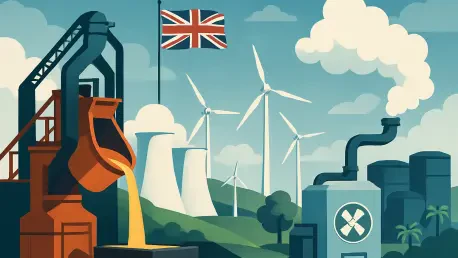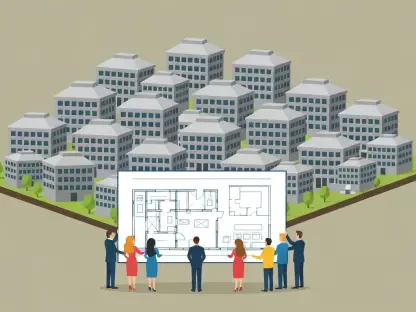The global steel industry stands at a critical juncture, grappling with its substantial contribution to greenhouse gas (GHG) emissions—estimated at 7-9 percent of the world’s total. With demand for steel continuing to rise, driven by infrastructure and renewable energy projects, the urgency to decarbonize has never been more pronounced. At the heart of this transformation is a historic agreement unveiled at the COP30 climate conference in Belém, Brazil, on November 14, which the UK steel sector has firmly endorsed. This pact aims to standardize emissions measurement and low-carbon steel classification across major producers, representing 60 percent of global output.
This market analysis delves into the implications of this landmark framework for the UK steel industry, a market that consumes 10.5 million tons annually while producing only 4 million. The purpose is to unpack current trends, data, and projections surrounding low-carbon steel, while exploring how this agreement could reshape trade, investment, and sustainability strategies. By examining the interplay of global standards and regional dynamics, this discussion aims to highlight the opportunities and hurdles that lie ahead for stakeholders.
The significance of this analysis extends beyond mere compliance; it offers a lens into how harmonized metrics could drive market fairness and innovation. Readers can expect insights into the balance between primary and secondary steel production, emerging decarbonization technologies, and the economic forces at play. The focus remains on equipping industry players with a clear understanding of where the market stands and where it is headed in this pivotal era of transition.
Market Trends and Projections: Decoding the Low-Carbon Steel Landscape
Global Alignment: A New Era for Steel Standards
The COP30 agreement marks a turning point for the steel market by introducing a unified sliding scale for classifying low-carbon steel, with progressively stricter criteria set to evolve toward 2050. This harmonization addresses long-standing discrepancies in GHG emissions measurement, which have historically distorted trade and investment decisions. Covering entities that account for 60 percent of global steel production—including key certification bodies like ResponsibleSteel—this framework promises enhanced transparency, a crucial factor for buyers and regulators navigating procurement for green projects.
For the UK, this global alignment offers a chance to streamline its position in international markets, particularly as a net importer. The clarity in standards is expected to facilitate better comparisons of steel products, potentially boosting demand for certified low-carbon materials. However, smaller producers may face initial costs in adopting robust monitoring systems to meet these metrics, though the long-term benefit of attracting sustainability-focused investments could offset such challenges.
Market projections suggest that standardized metrics will catalyze a shift in competitive dynamics over the next decade. Analysts anticipate that by 2030, regions adopting these standards early could gain a first-mover advantage in green steel exports. The UK, with its strong advocacy for the agreement, stands to benefit if domestic policies align swiftly, though delays in national strategies could temper this potential edge.
Primary Steel’s Carbon Burden: Market Realities and Shifts
A core component of the COP30 framework targets emissions from primary steel production, which relies on coal-fueled blast furnaces and generates significantly higher carbon output than secondary steel made from scrap in electric arc furnaces (EAFs). Currently, secondary steel satisfies about 30 percent of global demand, with projections indicating a rise to 50 percent by 2050, driven by recycling efforts. Despite high recycling rates—80 to 85 percent of scrap steel is reused—supply constraints are expected to persist for decades, keeping primary production central to meeting market needs.
This duality presents a complex challenge for the steel market: decarbonizing primary production through innovations like hydrogen-based reduction or carbon capture, while simultaneously expanding EAF capacity. For the UK, heavy reliance on imports amplifies risks if global primary steel fails to transition quickly, potentially inflating costs for low-carbon materials. On the flip side, opportunities exist in pioneering technologies, with early adopters likely to capture market share in the growing green steel segment.
Data indicates that investment in decarbonization technologies could reshape cost structures significantly by 2035, with low-carbon primary steel potentially accounting for over 20 percent of output if funding aligns with policy support. However, fluctuating energy prices for alternatives like hydrogen pose a risk to adoption rates. The market’s response to the COP30 emphasis on primary steel emissions will likely hinge on coordinated international efforts and robust financial backing for infrastructure upgrades.
UK Market Dynamics: Opportunities Amid Policy Delays
Regional nuances add depth to the market analysis, particularly for the UK, where diminished domestic production contrasts with high consumption levels. The COP30 agreement’s standardized benchmarks offer a strategic advantage in trade negotiations for low-carbon steel, potentially positioning the UK as a key player in sustainable procurement. Yet, the absence of a finalized national decarbonization roadmap—part of the delayed “Plan for Steel” strategy now expected by late 2025—creates uncertainty for local stakeholders.
Industry insights highlight a critical gap: while secondary steel via EAFs reduces project-specific carbon footprints, it does not address global emissions if primary production elsewhere remains unchanged. This underscores the need for comprehensive policies that incentivize both domestic innovation and international collaboration. The UK trails behind peers like Germany in scaling green technologies such as hydrogen steelmaking, a lag that could impact its competitiveness if not addressed promptly.
Looking forward, market observers predict that government subsidies and regulatory frameworks will be decisive in the next five years. The EU’s Carbon Border Adjustment Mechanism, set for full implementation by 2026, could further pressure global producers to align with low-carbon standards, indirectly benefiting the COP30 framework. For the UK steel market, bridging policy gaps with actionable timelines and funding will be essential to capitalize on this global shift and avoid being sidelined in the race toward sustainability.
Emerging Innovations: Shaping the Future Steel Market
Beyond current trends, the steel industry is witnessing a wave of technological advancements poised to redefine market landscapes. Hydrogen-based direct reduction of iron ore and carbon capture systems are gaining traction as viable solutions for cutting emissions in primary steel production. Digital tools, such as blockchain for supply chain transparency, are also emerging as vital components for enforcing standardized emissions tracking under the new global framework.
Economic and regulatory shifts are expected to influence market trajectories significantly. Potential UK government incentives for green steel initiatives, hinted at in ongoing policy discussions, could accelerate technology adoption if rolled out effectively. Projections suggest that by 2035, a substantial portion of steel production could leverage low-carbon methods, provided energy costs stabilize and geopolitical tensions over trade do not derail progress.
Risks remain, including the high capital required for infrastructure upgrades and uncertainties in scaling innovations like hydrogen production. Nevertheless, the momentum from the COP30 agreement points to a future where standardized metrics and cutting-edge solutions converge to normalize low-carbon steel. For the UK market, staying competitive will depend on leveraging these trends through strategic partnerships and proactive investment in sustainable practices.
Reflecting on the Path Forward: Strategic Insights for Steel Stakeholders
Looking back, the COP30 Low-Carbon Steel Agreement emerged as a defining moment for the global steel market, uniting major producers under a shared framework for emissions measurement and classification. The UK steel industry’s endorsement reflected a commitment to sustainability, despite domestic policy delays and regional challenges. The detailed analysis of market trends, from primary steel’s carbon burden to emerging innovations, underscored the complexity of transitioning to a greener economy.
For stakeholders, the insights gained pointed to actionable next steps. Industry players were encouraged to prioritize alignment with standardized metrics to secure market access and attract investment, while advocating for accelerated government support in decarbonization technologies. Policymakers faced the task of integrating global frameworks into national strategies, ensuring that funding and timelines matched the urgency of climate goals.
Beyond immediate actions, the broader consideration was fostering international cooperation to address systemic issues like scrap shortages and energy costs. The groundwork laid by this agreement offered a cohesive direction, suggesting that sustained collaboration could position the steel market as a leader in industrial decarbonization. The challenge ahead was clear: transform commitments into measurable outcomes, ensuring that sustainability became not just a target, but a defining trait of the industry.









